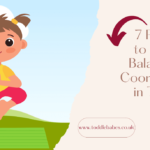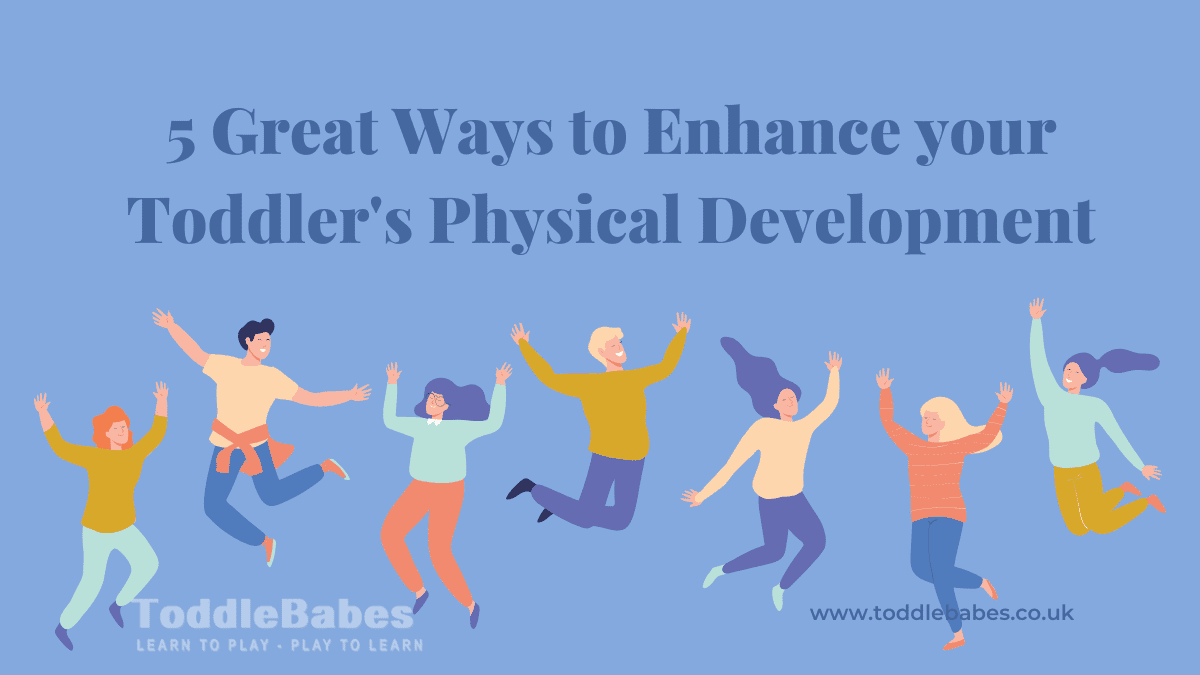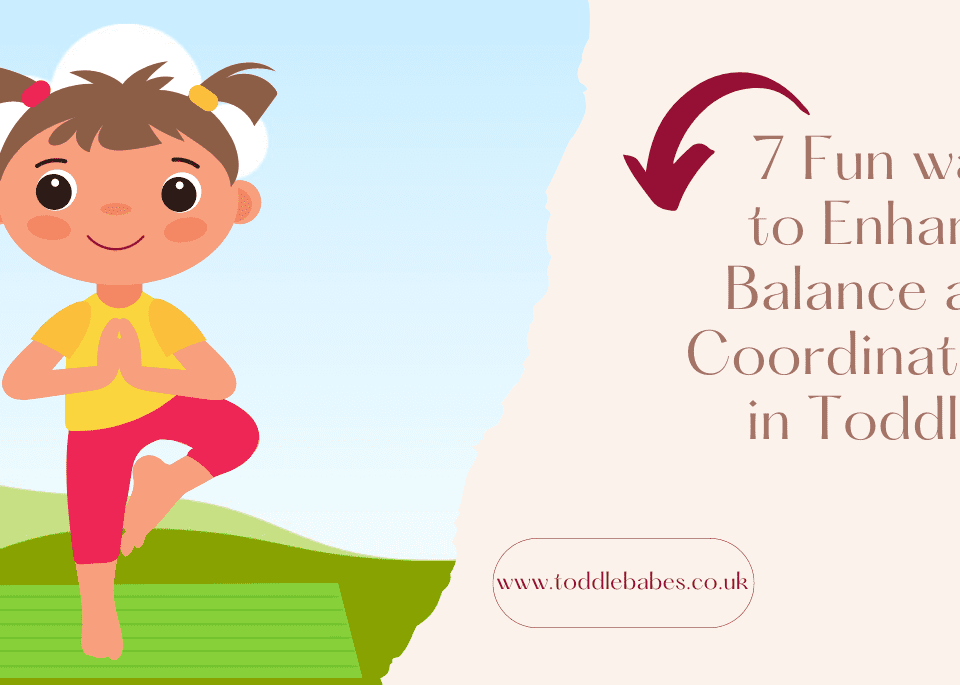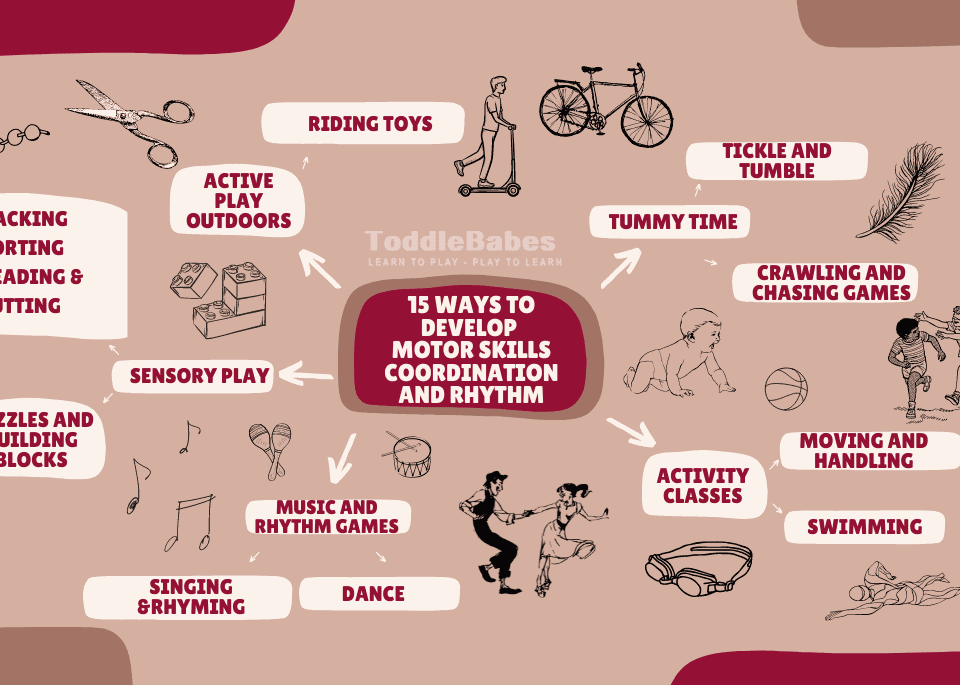
7 Fun Ways to Enhance Balance and Coordination

Toddlers are bundles of energy, constantly on the move and eager to explore the world around them. Engaging in active play and outdoor adventures not only allows them to burn off energy but also promotes physical development, social skills, and a love for the great outdoors. In this article, we will discuss exciting activities that can be incorporated into the daily routine of toddlers, keeping them active, happy, and engaged.
Benefits of Active Playtime and Outdoor Adventures
Active playtime and outdoor adventures offer a multitude of benefits for young children, encompassing physical, social, cognitive, and emotional aspects of their development. By encouraging children to engage in these activities, you provide them with opportunities for growth, learning, and enjoyment. Here are some of the key benefits associated with active playtime and outdoor adventures:
- Physical Development: Active play and outdoor adventures are essential for promoting physical development in toddlers. Running, jumping, climbing, and exploring the playground or natural environments contribute to the development of gross motor skills, coordination, balance, and overall physical fitness. These activities strengthen muscles, improve agility, and enhance spatial awareness, enabling children to move confidently and navigate their surroundings.
- Social Interaction: Visiting playgrounds and participating in outdoor activities create valuable opportunities for children to interact with their peers. Engaging in games, sharing equipment, and cooperating in group activities foster social skills, such as communication, collaboration, and problem-solving. Through these social interactions, children learn to take turns, negotiate, and respect others’ boundaries, laying the foundation for healthy social relationships and effective teamwork.
- Cognitive Stimulation: Active play and outdoor adventures provide rich cognitive stimulation for toddlers. These experiences encourage problem-solving as children navigate obstacles, plan their movements, and adapt to new environments. Outdoor exploration promotes curiosity and discovery, stimulating a sense of wonder and encouraging children to ask questions and seek answers about the world around them. They learn to observe and categorize objects, identify patterns, and engage in imaginative play, fostering creativity and critical thinking skills.
- Emotional Well-being: Engaging in physical activities outdoors has a profound impact on a child’s emotional well-being. Active playtime allows children to release energy, reduce stress, and enhance mood through the release of endorphins. The outdoor environment offers space for freedom and self-expression, promoting a sense of joy, happiness, and excitement. Connecting with nature has a calming effect, fostering a sense of tranquillity and grounding. Outdoor adventures provide a platform for children to develop confidence, overcome challenges, and build resilience, contributing to positive self-esteem and emotional growth.
- Appreciation for Nature: Active play and outdoor adventures expose children to the natural world, fostering an appreciation for nature and environmental stewardship from an early age. Exploring the outdoors allows children to experience the beauty and diversity of the environment, developing a connection and respect for the natural world. They learn about different plants, animals, and ecosystems, gaining a deeper understanding of their interdependence. This early exposure instils a sense of responsibility towards preserving the environment and encourages a lifelong love for nature.
Incorporating active playtime and outdoor adventures into a child’s routine is crucial for their holistic development. These activities not only promote physical fitness but also nurture social skills, cognitive abilities, and emotional well-being. By encouraging children to embrace the outdoors, you provide them with invaluable opportunities for growth, learning, and the joy of connecting with the natural world. So, get ready to embark on exciting outdoor adventures and witness the multitude of benefits that active playtime brings to your child’s development.
Playground Visits
Visiting the playground is a classic and enjoyable way to encourage physical activity, which enhances physical development, and social interaction in toddlers. The playground offers a wide range of play structures and equipment designed to engage children’s curiosity, stimulate their imagination, and promote their physical development. With proper guidance and supervision, parents and caregivers can make the most of their child’s playground experience by incorporating a few key strategies.
Ensuring safety is paramount when taking a toddler to the playground. Before heading to the playground, it’s essential to check the equipment for any potential hazards or damage. Inspect the swings, slides, climbing structures, and other equipment to ensure they are in good condition and meet safety standards. Additionally, choose a playground that is age-appropriate and suitable for toddlers, with appropriate safety measures in place, such as soft surfacing or safety gates.
Once at the playground, actively engage with your child and encourage their exploration. Follow their lead as they navigate the various play structures, providing support and guidance when necessary. Allow them to explore and experiment with different activities, such as climbing, sliding, swinging, and crawling. This freedom to explore helps develop their physical development which includes coordination, balance, and motor skills.
While encouraging independent play, it’s important to supervise your child closely to ensure their safety. Keep an eye on their interactions with other children and step in if necessary to promote positive social interactions and prevent any potential conflicts. Encourage your child to take turns, share toys, and interact with other children, fostering their social skills and ability to navigate social situations.
Make the most of the playground experience by introducing new challenges and activities that are appropriate for their age and developmental stage. For example, you can encourage your child to climb higher on the play structure or attempt different ways of going down the slide. This promotes their physical development, builds their confidence, and encourages them to explore their capabilities.
Take advantage of the natural learning opportunities that the playground offers. Engage your child in conversations about their surroundings, such as identifying colours, shapes, and numbers on the play equipment. Encourage imaginative play by pretending the play structure is a castle or a spaceship, sparking their creativity and cognitive development.
Ensure that the playground visit is a positive and enjoyable experience for your child. Offer words of encouragement, praise their efforts, and celebrate their accomplishments. This positive reinforcement helps build their self-esteem and reinforces their enjoyment of physical activity. Take time to bond with your child by joining them in play, whether it’s swinging together or going down the slide side by side. Your active participation not only strengthens your relationship but also models healthy and active behaviour.
Lastly, remember to pack some essentials for your playground visit. Bring along a water bottle to keep your child hydrated, as physical activity can be tiring and cause dehydration. Sunscreen is crucial to protect their delicate skin from the sun’s harmful rays. It’s also a good idea to have some snacks available to refuel your child’s energy during or after playtime.
Visiting the playground offers numerous benefits for toddlers, promoting physical activity, social interaction, and cognitive development. By ensuring their safety, actively engaging with them, introducing new challenges, and fostering positive experiences, parents and caregivers can maximize the benefits of their child’s playground visit. It’s an opportunity to create lasting memories, bond with your child, and lay the foundation for a lifelong love of active play.
Here’s how to make the most of their playground experience:
Climbing
Encourage your child to climb on age-appropriate structures like ladders, stairs, and low platforms. Climbing helps develop strength, coordination, and balance.
Encouraging your child to climb on age-appropriate structures can have a profound impact on their physical development. Climbing is a natural and instinctive activity for young children, and it offers a range of benefits that contribute to their strength, coordination, and balance.
One of the primary benefits of climbing is the development of strength. As children engage in climbing activities, they rely on their muscles to support their body weight and navigate the various surfaces and obstacles. Climbing requires the use of upper body strength, such as the arms, shoulders, and core muscles, as well as lower body strength in the legs and hips. By repeatedly engaging in climbing movements, children gradually build their muscular strength and endurance.
In addition to strength development, climbing also enhances coordination and motor skills. When children climb, they must coordinate their movements, both in terms of their limbs and their overall body positioning. Climbing requires precise coordination between the hands and feet, as well as a sense of spatial awareness to navigate the climbing structure effectively. By practising these coordinated movements, children improve their overall motor skills and develop a greater sense of body control.
Balance is another crucial skill that is developed through climbing. As children navigate uneven surfaces and negotiate different heights, they must constantly adjust their balance to maintain stability. Climbing helps children refine their proprioceptive abilities, which is their body’s awareness of its position in space. This sense of balance is essential for everyday activities and is particularly relevant in sports and physical activities that require stability and coordination.
When encouraging your child to climb, it is important to consider their age and physical abilities. Start with age-appropriate structures that provide a safe and supportive environment for climbing. Low platforms, gentle slopes, and short ladders are suitable options for toddlers and young children. These structures offer opportunities for climbing while minimizing the risk of falls or injuries. As your child gains confidence and develops their climbing skills, you can gradually introduce more challenging climbing structures.
While your child is climbing, it is important to provide close supervision and support. Offer guidance and reassurance as they navigate the climbing structure, ensuring they understand the safest routes and techniques. Encourage them to use both their hands and feet to maintain balance and stability. However, it is essential to strike a balance between providing guidance and allowing your child to explore and problem-solve independently. Allowing them to experiment and learn from their own experiences helps foster their confidence and resilience.
It’s worth noting that climbing should always take place in a safe and supervised environment. Ensure that the climbing structures are well-maintained, free from hazards, and appropriate for your child’s age and abilities. Soft surfaces such as rubber matting or grass beneath the climbing area can provide a cushion in case of any falls.
Encouraging your child to climb on age-appropriate structures offers a multitude of benefits for their physical development. It helps build strength, coordination, and balance while fostering their confidence and problem-solving skills. By providing a safe and supportive environment and closely supervising their climbing activities, you can facilitate their growth and enjoyment of this natural and beneficial form of physical activity.
Swinging
Push your child gently on the swings or support them as they learn to swing independently. Swinging is a popular activity that children of all ages enjoy, and it offers numerous benefits for their development. Whether you push your child gently on the swings or support them as they learn to swing independently, this activity has a positive impact on their vestibular development, coordination, and sense of rhythm.
One of the primary benefits of swinging is its effect on vestibular development. The vestibular system, located in the inner ear, plays a crucial role in maintaining balance, spatial orientation, and coordination. When a child swings back and forth, their vestibular system is stimulated as they experience a rhythmic movement and changes in gravitational forces. This stimulation helps develop and strengthen the vestibular system, which in turn contributes to their overall sense of balance and coordination.
Swinging also enhances coordination skills. As children swing, they must synchronize their movements with the swinging motion. They learn to pump their legs in a coordinated manner to maintain the swinging motion or adjust their body position to control the direction and speed of the swing. This coordination of movements between the upper and lower body supports the development of gross motor skills and enhances overall body awareness.
Additionally, swinging provides children with a sense of rhythm. The rhythmic motion of swinging helps children internalize and understand the concept of rhythm. They begin to develop a sense of timing and coordination between their movements and the swinging motion. This rhythmic experience can extend beyond swinging and contribute to their ability to appreciate and engage in various activities involving rhythm, such as dancing or playing musical instruments.
When pushing your child on the swings, it is important to do so gently and at a pace that is comfortable for them. Allow them to experience the sensation of swinging while ensuring their safety. As they become more comfortable, you can gradually increase the height or speed of the swing, always within safe limits. Encourage them to hold onto the ropes or chains and engage their core muscles to maintain stability and control.
As your child grows and develops, you can support them in learning to swing independently. Start by providing assistance and guidance as they learn to pump their legs to generate their own swinging motion. You can stand beside them, holding their hands or waist for support, and gradually decrease your assistance as they gain confidence and develop the necessary coordination and strength to swing on their own.
It is important to note that swinging should always take place in a safe environment, with appropriate safety measures in place. Ensure that the swing set is stable, the seat is secure, and the area around the swing is clear of obstacles. Soft surfaces such as rubber matting or wood chips beneath the swing set can provide a cushion in case of any falls.
Swinging is a delightful and beneficial activity for children. By gently pushing them on the swings or supporting them in learning to swing independently, you enhance their vestibular development, coordination, and sense of rhythm. Embrace the joy and freedom that swinging offers, while ensuring their safety and providing them with opportunities for growth and development through this enjoyable form of play.
Sliding
Assist your child in navigating the slides, promoting spatial awareness and motor planning. Ensure the slides are appropriate for their age and provide a safe landing area.
Sliding is a popular activity among children that offers numerous benefits for their development. As a caregiver, you play a vital role in assisting your child in navigating the slides, ensuring their safety, and promoting their spatial awareness and motor planning skills. Here’s why sliding is beneficial and how you can enhance the experience for your child:
- Motor Planning: Sliding requires children to plan and execute their movements as they climb up the ladder or steps and position themselves on the slide. They learn to assess the space available, adjust their body position, and coordinate their movements to slide down smoothly. By engaging in this activity, children develop their motor planning abilities, which are essential for coordinating and executing actions effectively.
- Spatial Awareness: Sliding helps children develop spatial awareness as they learn to navigate the slide and understand their body’s position in relation to the slide’s structure. They learn to judge the speed and trajectory of their descent, adapt their body movements accordingly, and position themselves appropriately to ensure a safe landing. Spatial awareness is crucial for various physical activities and daily tasks, and sliding provides a fun and engaging way for children to develop this important skill.
- Balance and Coordination: Climbing up the ladder or steps to reach the top of the slide requires balance and coordination. As children ascend the structure, they develop their core strength, balance, and coordination. They learn to stabilize their bodies and make controlled movements, promoting their physical stability and overall body control.
- Sensory Stimulation: Sliding offers sensory stimulation as children experience the thrill of the slide’s movement and the sensation of gliding down. They engage their vestibular system, which helps with balance and spatial orientation, and their proprioceptive system, which provides feedback about body position and movement. This sensory input contributes to a rich sensory experience, promoting sensory integration and enhancing their overall sensory processing skills.
To ensure a safe and enjoyable sliding experience for your child, consider the following tips:
- Age-Appropriate Slides: Choose slides that are appropriate for your child’s age and developmental stage. Ensure that the slide’s height, size, and structure are suitable for their abilities. Avoid slides that are too tall or steep for younger children, as they may pose safety risks.
- Supervision: Supervise your child closely while they engage in sliding. Offer guidance and support as needed, especially if they are new to sliding or still developing their motor skills. Stay nearby to ensure their safety and intervene if necessary.
- Safe Landing Area: Check that the slide has a safe landing area with a soft surface, such as rubber mulch, sand, or grass, to cushion any potential falls. Ensure there are no obstacles or hazards near the slide’s exit to prevent accidents.
- Encourage Safe Sliding: Teach your child to slide feet first and to wait for the previous child to clear the slide before sliding down themselves. Emphasize the importance of taking turns and respecting others’ space while using the slide.
By incorporating sliding into your child’s playtime and following safety precautions, you provide them with a fun and beneficial activity. Sliding promotes motor planning, spatial awareness, balance, and coordination, all of which contribute to their overall physical development. So, encourage your child to explore the joy of sliding while ensuring their safety, and watch them thrive in their play experiences.
Nature Scavenger Hunts
Exploring the outdoors and engaging in nature scavenger hunts stimulates curiosity, physical activity, and a connection with the natural world.
Exploring the outdoors and engaging in nature scavenger hunts is a fantastic way to inspire curiosity, promote physical activity, and foster a deep connection with the natural world. Organizing a simple scavenger hunt can be a fun and educational experience for children, allowing them to engage their senses, learn about the environment, and develop important skills. Here’s a step-by-step guide on how to organize a memorable and exciting nature scavenger hunt for your child:
- Choose a Location: Select a suitable outdoor location for the scavenger hunt, such as a local park, nature reserve, or even your own backyard. Consider the age of the participants and ensure the location is safe and accessible.
- Create a Checklist: Prepare a checklist of items or nature-related objects for the scavenger hunt. The items can vary depending on the season, location, and the specific interests of the children. Include a mix of natural elements like leaves, rocks, flowers, or pinecones, as well as specific observations like finding a bird’s nest or spotting a certain type of insect. Make the checklist visually appealing and age-appropriate, using pictures or simple descriptions that the children can understand.
- Provide Supplies: Equip each participant with a small bag or container to collect their findings. You can also provide them with a magnifying glass, binoculars, or a field guide to enhance their observation skills and make the experience more engaging. Encourage them to bring a notebook and pencil to jot down any interesting discoveries or sketch the items they find.
- Explain the Rules: Gather the participants and explain the rules of the scavenger hunt. Emphasize the importance of respecting nature and its inhabitants, reminding them not to disturb or harm any living organisms they encounter. Encourage them to work individually or in teams, depending on the number of participants, and explain the time limit, if applicable.
- Start the Hunt: Release the participants to begin their scavenger hunt adventure! Encourage them to use their senses and observation skills to locate the items on the checklist. Remind them to stay within the designated area and to be mindful of their surroundings.
- Encourage Exploration: As the participants search for the items on the checklist, encourage them to explore their surroundings and appreciate the beauty and diversity of nature. Encourage them to examine different textures, listen to the sounds of the environment, and take note of any interesting plants, animals, or natural features they encounter.
- Reflect and Share: After the designated time, gather the participants together to reflect on their scavenger hunt experience. Allow each participant to share their findings, observations, and any interesting facts they learned along the way. This provides an opportunity for children to learn from each other, share their excitement, and deepen their understanding of the natural world.
- Extend the Learning: To extend the learning experience, consider incorporating additional activities or discussions related to the scavenger hunt. You can discuss the importance of conservation, and the role of different organisms in the ecosystem, or even engage in a nature-inspired art or craft activity using the collected items.
By organizing a nature scavenger hunt, you not only encourage physical activity and curiosity but also cultivate a sense of wonder and appreciation for the natural world. It allows children to develop important skills such as observation, problem-solving, and critical thinking while fostering a lifelong love for nature and environmental stewardship. So get ready to embark on an exciting adventure, exploring the great outdoors and creating lasting memories with your child through a nature scavenger hunt.
Fun with Balls
Balls provide endless opportunities for active play, gross motor skill development, and coordination in children. Incorporating ball-related activities into your child’s playtime can be both enjoyable and beneficial for their physical and cognitive development. Here are some exciting ball activities you can introduce to your child’s play routine:
- Throwing and Catching: Encourage your child to engage in throwing and catching activities using a softball. Set up targets, such as buckets or designated spots, and have your child aim and throw the ball towards them. You can also play catch with your child or involve a playmate for added fun. Throwing and catching games enhance hand-eye coordination, motor planning, and gross motor skills. They help children learn to judge distances, improve their aim, and refine their ability to catch and grasp objects.
- Kicking: Create a mini soccer goal using cones or other markers and encourage your child to kick a ball towards the target. This activity not only promotes leg strength, balance, and coordination but also introduces them to basic soccer skills. As they practice kicking, children develop their ability to control their leg movements, generate force, and aim accurately. Kicking a ball engages various muscle groups in the legs, including the quadriceps, hamstrings, and calf muscles, promoting physical fitness and motor skill development.
- Rolling Games: Sit facing your child and initiate a rolling game by rolling a ball back and forth between the two of you. Encourage your child to roll the ball back to you using their hands. This activity promotes social interaction, cooperation, and hand-eye coordination. Rolling games help children refine their motor skills, as they learn to control the force and direction of the ball’s movement. They also foster communication and turn-taking skills, as children learn to wait for their turn and respond to cues from their play partners.
Incorporating these ball activities into your child’s playtime provides numerous benefits beyond physical development. They promote social interaction, cooperation, and communication skills as children engage in these games with you or their playmates. These activities also enhance cognitive skills, such as problem-solving and spatial awareness, as children anticipate the movement of the ball and adjust their actions accordingly.
Remember to create a safe play environment by ensuring there is enough space for throwing, catching, and kicking activities. Use soft or lightweight balls that are appropriate for your child’s age and developmental stage. Supervise the activities and provide guidance and encouragement as needed. Celebrate their successes and support them in overcoming any challenges they may encounter.
By incorporating these ball-related activities into your child’s play routine, you provide them with opportunities for active engagement, skill development, and enjoyment. The versatility and accessibility of balls make them an excellent tool for fostering physical, cognitive, and social growth in children. So, get ready to have fun with balls and witness the joy and development that these activities bring to your child’s playtime.
Active playtime and outdoor adventures are essential for the development of toddlers, providing opportunities for physical activity, social interaction, and a deeper connection with nature. Whether it’s visiting the playground, organizing nature scavenger hunts, or engaging in ball games, these activities contribute to their physical, social, and cognitive growth. Embrace the energy and curiosity of toddlers by incorporating these exciting activities into their routine, fostering a love for physical activity and the great outdoors.

I am a preschool and primary school teacher and mum to 3 children. I have been involved in education since 1997 and have trained in a variety of educational specialist areas. It is with this expertise that I write articles to help parents and educators provide quality learning experiences for the children in their care.




